Gas Extraction Suits
Gear up for flash fire hazards!
Introduction
When a leak occurs the propane or natural gas will tend to accumulate in the hole. If the accumulated gas ignites, a severe flash fire event is created and the worker must be” extracted” as quickly as possible. In 2018, The American Gas Association along with industry experts did a study on Natural Gas Workers and Natural Gas Fires that indicated that the reaction time and extraction typically takes 6 seconds or less for a worker to get a safe distance away from the flash fire or to extinguish the fire. However, additional case studies have shown that more time is needed when heavy equipment is being used or extenuating extraction circumstances exist.
Oberon Company has designed an 8 and 15 second Gas Extraction Suit which can protect a worker exposed to this type of flash fire hazard based on instrumented manikin testing according to ASTM F1930 conducted at Aitex Laboratory in Spain. The Oberon GES™ Series Gas Extraction Suit is comprised of a balaclava and coverall design, which includes a harness port in the upper back area. This permits the harness to be worn under the Gas Extraction Suit so that only the lanyard is outside of the suit in the exposure area. The suit should be used in conjunction with a radiant heat shielding SCBA and multilayer heat protective glove.
Flame Resistant Clothing Used to Address Fire Hazards
It is not possible to accurately predict the exposure level for a flash fire hazard. A flash fire could result from the ignition and continued burning of a large gas cloud fed by a major gas leak, or a small amount of gas from a slow leak. The duration of a flash fire could range for hours at a large refinery fire or seconds for a small gas leak or a small chemical spill. The goal of wearing flame resistant clothing for a flash fire hazard is to save the life of the worker and to reduce burn injuries. A second goal is to minimize 3rd degree burn injury which tends to require long hospitalization, skin graft surgery and extensive rehabilitation. If the total burn injury can be limited to less than 50% of the body area and 3rd degree burn injury area can be reduced to a few percent of the total body area, there is a high probability that the burn victim will survive and that the quality of life for the worker can be preserved.
To summarize, the typical approach for industrial flash fire hazards is to wear a flame resistant coverall or a flame resistant shirt and pants. Employers are essentially accepting that their workers will receive substantial burn injury in the event of a flash fire, but will have a high probability of surviving the incident. To put this in perspective, if non flame resistant work clothing is worn in a flash fire accident of 4 seconds, the body burn injury can exceed 90% of the body area, and a fatality is very likely. Since flammable clothing burning on the human body for about 15 seconds begins to create substantial areas of 3rd degree burn, the quality of life cannot ever be fully recovered after this type of extensive burn injury.
Escape Time
Another concept used in flash fire exposures is “escape time”. This is a measurement of the time needed to escape from the fire before you sustain life-threatening levels of burn injuries. The purpose of the Oberon gas extraction suit is to buy the worker more time to escape to safety or extinguish the flame.
Heat Intensity
We call the heat intensity of a flash fire “heat flux”. It represents the flow of heat energy onto a surface. In laboratory testing, the surface of the mannequin is fully covered by sensors that measure areas where burns would occur. In real life accidents, the surface receiving the heat is the workers clothing or exposed skin. Heat Flux Levels for a flash fire are 1 to 3 cal/cm2s (test methods use a value of 2-3 cal/cm2s).
Exposure Times
For a flash fire, 6 seconds is seen as the typical “Escape Time”, with much longer periods observed when extenuating circumstances exist. Typical flame resistant (FR) coveralls used for industrial flash fire protection meet the NFPA 2112 protection requirements that a user will sustain less than 50% body area burn injury in a 3 second simulated flash fire. We feel the prolonged flash fire hazard, such as gas leak fires, can be more severe than a typical flash fire in that the exposure can be significantly longer than 3 seconds. In this case a single layer FR coverall will not provide sufficient protection. Oberon’s GES™ Series coveralls coupled with a balaclava and an SCBA respirator mask are designed to provide significantly greater protection. In an 8 or 15 second simulated flash fire test the measured 2nd and 3rd degree burn injuries observed were very low. If a worker is exposed to a prolonged flash fire the Oberon GES™ Series suit can dramatically increase the probability of survival, while also allowing the survivor to have a high quality of life after the accident.
To cite a similar example, fire fighter turnout gear is typically tested at 10 seconds when it is evaluated according to ASTM F1930. Results from turnout gear that meet NFPA 1971 requirements, show body burns in the range of less than 5% -10%.
Standards
ASTM D6413: All fire resistant materials used for flash fire hazards must pass D6413 the vertical flame test.
NFPA 2112 is the garment specification standard for fire resistant clothing to protect workers from industrial flash fires. It requires ASTM F1930 instrumented manikin test of 3 seconds for a standard fire resistant coveralls plus cotton T-shirt and briefs.
- The sum of 2nd degree and 3rd degree Body area burn injury must be 50% or less.
- The probability for a person to survive 50% burn injury is fairly high especially for victims less than 50 years old (see Figure 2 at the end). It is important to recognize that we far exceed the protection requirements of the NFPA 2112 standard. Our aim is to reduce burn injury to close to zero for an 8 or 15 second exposure as opposed to the NFPA 2112 requirement for less than 50% body area burn injury for a 3 second exposure.
Not a Typical Fire Hazard
Since the work on a gas line usually occurs in a situation where the worker will need to be “extracted”, the escape time could be up to 15 seconds due to the time for personnel tending the safety line to react to the emergency (they will also be impacted by the fire) and to apply the needed force to pull the worker out of the flash fire area. The Oberon Gas Extraction suit is designed to provide 8 or 15 seconds of “escape time” from flash fire and leave the worker with only a few percent of body area burn injury.
The chart above was taken from The American Burn Association’s 2015 Annual Report. It shows the survival rate of burn injury victims for age groups 20-69. The total body burn percentage was taken by adding up the total amount of 2nd and 3rd degree burn injuries. When analyzing the chart it becomes very clear that the probability of survival goes up dramatically when the overall body burn percentage falls below 25%.





